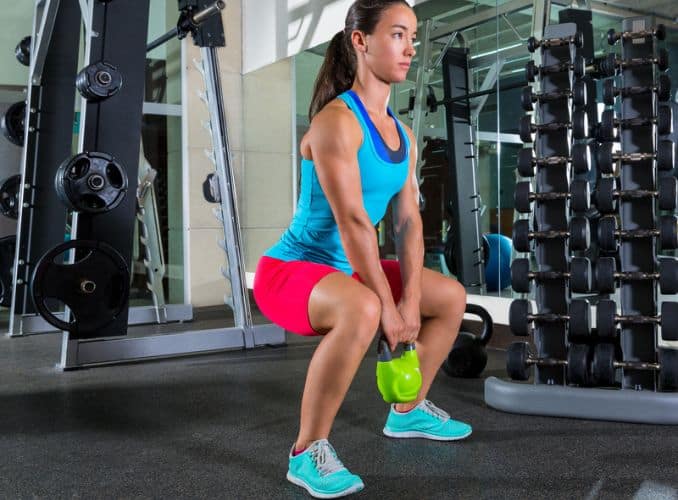Cueing is about ensuring the athlete knows exactly what you want them to do, especially when performing exercises like the goblet squat to prevent back pain.
According to the study [1], cueing can assist in the correction of miscomprehension of instructions and poor neuromuscular coordination and recruitment.
Cues can be in the form of verbal instruction, physical manipulation, and/or visual aids, all of which have the potential to aid an athlete in achieving the desired technique and mechanics during the exercise.
When it comes to squatting, things can get a little bit tricky. There are a lot of different variations of the squat, and most of them have different cues.
However, there aren’t many options for cueing regarding the goblet squat.
Goblet squats [3] are great for building leg and core strength while improving mobility. It’s a popular exercise that strengthens lower body muscles.
Holding a weight close to your chest helps engage muscles effectively, promoting proper posture.
While goblet squats are highly effective, improper form—such as rounding the back or neglecting core engagement—can result in back pain.
This guide will provide detailed instructions to help you perform goblet squats safely, minimize discomfort, and maximize their benefits.
Medical Disclaimer: The information in this blog is for educational purposes only and is not intended to replace professional medical advice. The content in this post is not meant to substitute for a professional medical diagnosis, advice, or treatment. Always ask advice from your physician or other qualified health providers with any questions you may have regarding a medical condition.
The Journal of Strength & Conditioning Research 2021 [2] says the goblet squat (GBS) is a squat variation with the weight held in front of the lifter using a dumbbell or kettlebell and has been used as a foundational exercise in squat progressions to teach proper form and body position
1. How to do the Goblet Squat
In the Goblet Squat , we got a nice wide stance.
We need lots of room for us to drop our hips past our knees and go through the movement.
In the exercise, we can hold a kettlebell or a dumbbell.
When we drop down into the bottom position of the goblet squat, the elbows are pushed against the knees, and then we come out of the bottom.
In other things, with Orsy, you can see that she is looking straight ahead.
Any head dropping will end up changing the position in the lower back.
You can see that she is good and strong in the shoulders, and then she is not collapsing forward, which will end up changing the position of your back and putting greater stress on it.
2. Common Mistake when Doing the Goblet Squat that Can Lead to Back Pain
And also, you can see with Orsy that her back is staying the same. She is not rounding out in that back.
She is holding that position, and she is working on that movement happening in the hips.
You can see that Orsy has nice wide feet, elbows are coming in between the knees, and the movement is happening in the hips.
There is no movement happening in that low back. She is strong and set on the shoulders.
She is strong and set in that core area. Her eyes and head are looking straight ahead.
3. Important Key When Performing the Goblet Squat
Make sure to remember thus cueing:
- Look at your head.
- Look at where your shoulders are.
- Look at where your core and abdominal area are.
- Look at how your low back is.
- Look at how your hips are.
- Look at where your knee and feet positions are.
Now, if you do a bodyweight style, the same thing applies. We want good technique because the poor technique in the feet and the knees leads to unnecessary stress and strain on the knees.
Poor technique in the hips, low back, mid-back, and head puts unnecessary stress on the lower back and could lead to irritation, pain, or injury.
What Is a Goblet Squat?
The goblet squat [4] is a squat variation where the weight (typically a dumbbell or kettlebell) is held in front of the lifter at chest level, encouraging an upright torso posture.
How to Properly Do Goblet Squat:

Start by standing with your feet shoulder-width apart and holding a kettlebell or dumbbell securely at chest height. Maintain an upright torso and brace your core.
Lower your body into a squat by pushing your hips back and bending your knees, keeping your chest lifted and then your spine neutral.
Make sure your knees align with your toes and avoid allowing them to collapse inward.
Lower until your thighs are parallel to the floor (or deeper, if your flexibility permits), then press through your heels to return to a standing position.
Maintain controlled breathing throughout the movement.
Benefits of Squats

- The Goblet Squat [5] is especially useful for improving quadriceps strength and vertical loading.
- Builds Lower Body Strength: Squats target major muscles in the legs, including the glutes, quadriceps, hamstrings, and calves. These muscles are crucial for movements like walking, running, and jumping.
- Core Activation: While squatting, your core muscles (including the rectus abdominis and erector spinae) engage to stabilize your spine, making squats an excellent way to strengthen your core.
- Improves Posture: Properly performed squats can help promote better posture by training your body to maintain an upright, neutral spine. This can be especially beneficial for individuals who spend a lot of time sitting.
- Boosts Athletic Performance: Squats enhance speed, power, and endurance, which directly translate to improved performance in sports and other physical activities.
- Increases Flexibility: Squatting helps increase flexibility in the hips, ankles, and lower back, improving overall mobility and preventing injuries.
- Supports Joint Health: Regular squatting helps strengthen the muscles around the knees, hips, and ankles, contributing to better joint stability and health.
How to Stop Back Pain During a Goblet Squat

Dr. Jen, a physical therapist, advises maintaining a neutral spine, engaging your core, and avoiding a hip hinge during goblet squats. Elevating heels can help improve form, reduce back strain, and then focus on your legs.
- Maintain a neutral spine by engaging your core throughout the movement.
- Keep your chest elevated, and your shoulders pulled back, and avoid rounding or arching your lower back.
- Start with lighter weights to perfect your form first, especially when doing a goblet squat to avoid back pain.
- Improve hip mobility to goblet squat back pain deeply without strain.
- Ensure knees track over toes and hips push back, not down.
- Incorporate exercises like bridges to strengthen glutes and then hamstrings.
- Use a mirror or record your form to ensure proper alignment during the exercise.
Reasons You Feel Goblet Squats in Your Back and Not Your Legs
- Lack of Core Activation: If your core muscles are not adequately engaged, your lower back may compensate, leading to strain and discomfort.
- Rounding Your Back: When you round your lower back during the squat, it puts excess stress on your spine and can lead to back pain.
- Weak Glutes and Hamstrings: If your glutes and hamstrings aren’t activated properly, your lower back can take over the movement, leading to discomfort.
- Improper Squat Depth: Squatting too shallow or excessively leaning forward shifts the load to your lower back instead of distributing it evenly across your legs.
- Lack of Hip Mobility: Limited hip flexibility can force your back to compensate, causing pain in the lumbar region, especially during movements like the goblet squat.
Final Thoughts
To prevent back pain during goblet squats, prioritize the correct form. Keep your core engaged, your chest lifted, and your spine neutral.
Begin with lighter weights to perfect your technique, and work on improving hip and ankle mobility.
These adjustments will help you perform goblet squats effectively, building strength without discomfort.
There you go, Mike Whitfield and everyone at Kettlebell Finishers (great kettlebell workout ideas here).
Say goodbye to discomfort and reclaim your life! Discover effective strategies and exercises for Low Back Pain Solved to relieve your pain and strengthen your back. Start your journey to a pain-free life today!
Frequently Asked Questions
Do goblet squats work your back?
Yes, goblet squats work your back, especially the core and leg muscles, to stabilize your spine.
They help strengthen your lower back and improve posture when done correctly, similar to front squats and back squats, by engaging your entire movement.
What is the disadvantage of the goblet squat?
The main disadvantage of goblet squats is the risk of back pain if your form is incorrect. Issues like poor ankle mobility, rounding your the back, or using too much weight can cause strain.
Ensure you keep your feet flat and knees in the same direction to avoid injury.
Is it normal for squats to hurt your back?
No, squats shouldn’t hurt your back if done properly. Back pain usually occurs when form is off, such as rounding your back, not engaging your core, or having limited ankle mobility.
Keep your feet flat and hips aligned in the same direction to squat pain-free.


